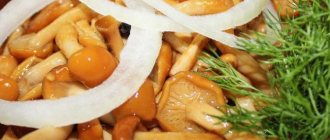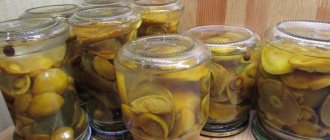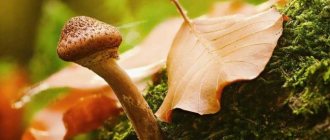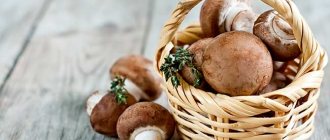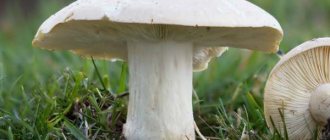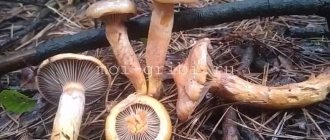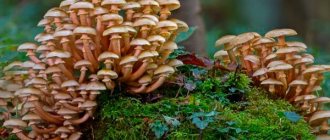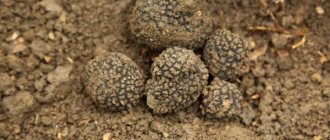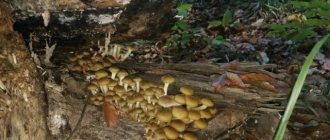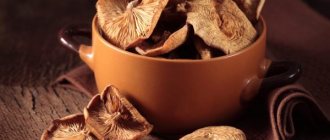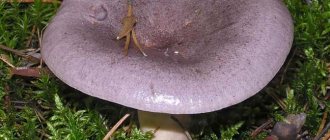Honey fungus
– one of the most popular mushrooms in the Russian Federation. The crop produces harvests several times a year, and experienced mushroom pickers can collect tens of kilograms of product in one wave of ripening. The winter and autumn representatives of the family are of greatest interest, since they are famous for the bright aroma and excellent taste of the fruiting bodies, and also grow in colonies, which greatly simplifies the process of searching and collecting.
Article on the topic - Types of forest mushrooms.
However, another subspecies of the plant we are considering is worthy of attention - royal honey mushrooms or Golden scale. Not many people collect them due to lack of knowledge. The name of the mushrooms speaks for itself; the culture is worth paying more detailed attention to.
Description of the appearance of royal honey mushrooms (golden scales)
The edible species has a large cap, broadly bell-shaped or flat-round in shape. The color of the cap is rusty yellow or dirty beige-golden, covered with red flake-like scales. The leg is relatively dense, yellowish-brown in color with multiple brownish scales on the surface, framed by a small fibrous ring, which disappears in adult specimens. Wide plates grow with teeth to the stem, have a light straw, olive or brownish color. The pulp has a pleasant mushroom aroma and a whitish-beige-yellow color.
Emergency care for mushroom poisoning
- Gastric lavage. At home, you should drink water and induce vomiting by pressing on the root of the tongue. In a hospital, this procedure is carried out using a probe.
- Cleansing enema. It is given if more than two hours have passed since the poisoning.
- Reception of adsorbents. Activated carbon, Enterosgel and other drugs will help bind toxins and neutralize them.
- Drinking salted water or drugs whose action is aimed at combating dehydration. Drink water in small sips, often. The drugs are taken according to the instructions. When the vomiting stops, the patient can be given strong, sweet tea.
- Wrapping up. The victim must be warmed up. Hypothermia may occur due to severe dehydration. Warm blankets, heating pads and complete rest are the first things to do when vomiting and diarrhea stop.
Taste qualities
According to mushroom pickers, the taste of this edible variety is practically not inferior to ordinary honey mushrooms. The mushroom pulp of fruiting bodies is perfect for use in hot and cold appetizers , exotic salads, and is widely used in the preparation of first and second courses. Excellent fleshy pulp, as well as the presence of a very unusual and rich taste and aroma, have long made royal honey mushrooms incredibly popular among chefs in many countries.
Habitat
As for habitats, most often royal honey mushrooms are found on the surface of fallen but still living trees or stumps. Spores can also land on the roots of growing trees and multiply there. The crop is considered a parasite and develops only on deciduous plants; if you find similar fruits on coniferous wood, it is better to pass by and refrain from harvesting.
Flakes are also collected abroad, and in China and Japan, royal honey fungus is grown purposefully, on an industrial scale.
Useful and healing properties
The medicinal and beneficial properties of mushroom pulp of this variety are due to its very rich chemical composition. Golden flake is considered extremely beneficial for the human body , due to the high content of trace elements and amino acids against the background of low calorie content.
Mushroom dishes are especially popular among vegetarians and anyone who, due to various circumstances, is forced to adhere to a low-calorie, but completely balanced diet. The pulp contains increased amounts of calcium and phosphorus, which make it possible, if necessary, to fully replace fish dishes.
SCALE OR PHOLIOTA SQUARROSA
This is one of the most common foliots in the genus, otherwise they are called dry, scaly, fleecy. They grow mainly on wood.
SCALE OR PHOLIOTA SQUARROSA
The veil, which we are accustomed to seeing on the folio of this species, is characteristic mainly of newly grown specimens, which later forms a distinctive skirt on their stem and looks like fleecy scales on the edge of the cap.
External description: sometimes mature mushrooms reach a cap diameter of 20 cm, but for the most part the diameter of this representative is 5–12 cm. Mature mushrooms have a hemispherical or conical cap, then it becomes flat-convex or protruding (highly convex) in shape. The slimy surface has bright yellow dry scales. They taste bitter, but are edible. When broken, the pulp has a whitish or yellowish color.
Where does golden scale grow (video)
Mushroom pulp is characterized by the content:
- dietary fiber – 5.1 g;
- water – 90 g;
- unsaturated fatty acids – 0.2 g;
- monosaccharides and disaccharides – 0.5 g;
- ash – 1.0 g;
- saturated fatty acids – 0.2 g;
- vitamin “B3” (PP) – 10.3 mg;
- vitamin “B1” (thiamine) – 0.02 mg;
- vitamin “B2” (riboflavin) – 0.38 mg;
- vitamin “C” (ascorbic acid) – 11.0 mg;
- vitamin “E” (alpha tocopherol) – 0.1 mg;
- vitamin “PP” (Niacin equivalent) – 10.7 mg;
- Calcium – 5.0 mg;
- Magnesium – 20.0 mg;
- Sodium – 5.0 mg;
- Potassium – 390-400 mg;
- Phosphorus – 43-45 mg;
- Iron – 0.7-0.8 mg.
It is also very important to consider the harm that can be caused by mushroom dishes. Fruiting bodies are not recommended for consumption by persons with gastrointestinal pathologies, as well as those with a history of food allergies or individual intolerances.
Related species
What kind of mushrooms are honey mushrooms?
Honey mushrooms are a group of mushrooms that includes a fairly large number of species belonging to different genera and even families. What they have in common is that most of them grow on living or dead wood.
Honey mushrooms are quite prolific and usually form large families and clusters, which allows the mushroom picker to quickly fill his baskets with mushroom trophies.
Information! Honey mushrooms are not one species, but a group of mushrooms belonging to different genera and even families.
Types of mushrooms
Beginning mushroom pickers often ask the question: what kinds of mushrooms are there? The golden scale has many relatives. First of all, you should pay attention that there is a genus of honey fungus (Armillaria), which includes:
- autumn honey fungus – Armillaria mellea;
- thick-legged honey fungus – Armillaria gallica;
- bulbous honey fungus – Armillaria bulbosa;
- dark honey fungus – Armillaria ostoyae, etc.
Honey mushrooms also include some species from the genus Marasmius:
- meadow honey fungus (meadow honey fungus) – Marasmius oreades;
- garlic honey fungus (common spadefoot) – Marasmius scorodonius;
- honey fungus – Marasmius bulliardii;
- sinewy-plate honey fungus (leaf rotting mushroom) – Marasmius epiphyllus, etc.
Honey mushrooms belonging to other genera and families:
- summer honey fungus (Kuehneromyces mutabilis) – Kuehneromyces mutabilis – genus Kuehneromyces, family Strophariaceae;
- spring honey fungus (collibia) – Gymnopus dryophilus – genus Gymnopus, family Marasmiaceae;
- mucous honey fungus (Oudemansiella mucosa) – Oudemansiella múcida – genus Oudemansiella, family Physalacriaceae, etc.
False doubles
The most common false double of the edible royal honey fungus is considered to be the inedible Fire Flame (Pholiota flammans). This variety does not contain toxins in its pulp , but the too bitter taste of the fruiting bodies makes them unsuitable for food use. The common saprotroph is characterized by a hemispherical or conical, convex and flat-convex cap, with bent edges, covered with dry scales of bright yellow or yellow-orange color.
The mushroom pulp is yellowish-orange or brownish, with an unexpressed earthy aroma and an unpleasant taste. The plates are of a narrowly adherent type, often arranged, grayish-yellow or brown. The leg region is hollow, with the presence of a fibrous-membranous ring, with a surface covered with bright yellow or brownish scales. Fungal spores are yellowish-brown, oblong. The fruiting bodies of this species grow en masse on dead or highly decaying wood, mainly coniferous trees.
How to distinguish a royal mushroom from a false one
As we said earlier, many lovers of forest gifts avoid delicious royal honey mushrooms. The fact is that the fruits of the crop can easily be confused with a false family - the inedible moth. In fact, it is enough to pay attention to the substrate in which the mushroom rhizome develops - the moth prefers ashes, both fairly fresh and overgrown with weeds or bushes.
You should also pay attention to the following nuances:
- Mushroom color;
- Smell;
- Peel.
What do false ones look like?
The color of the inedible moth is much brighter than that of its edible “relative”; nature made sure that the fruit attracts attention with its appearance.
As for the aroma that false honey fungus exudes, it can hardly be called mushroom or pleasant. In addition to all this, the surface of the cap of a dangerous plant is covered not only with scales, but also with a thin layer of mucus if dampness prevails outside.
A few more doubles of the royal delicacy are cinder and slimy flakes.
The photo shows the false honey fungus Sulfur-yellow.
The first is distinguished by a too bright, orange cap, the absence of a ring around the stem and the presence of scraps of skin along the edges of the cap. The second has a bell-shaped, slightly concave head shape and sticky flesh.
Well, another dubious representative of the scale family is the “ordinary” species. It can be eaten, but only if certain rules are followed and with extreme caution.
The mushroom contains opium, which causes hallucinations, and becomes completely harmless only after prolonged heat treatment. It is also strictly contraindicated to combine such fruits with alcohol - there is a high risk that the body will receive severe poisoning, the consequences of which cannot be predicted.
Whatever gifts of nature a person collects, it is always important to remember one thing - if a mushroom seems unfamiliar to you and raises doubts, pass by. As a last resort, always be on the safe side by having a photo of the fruit you are going to collect; compare the harvest you find with the image.
Useful video: Fire scale (Pholiota flammans) - inedible
The use of royal honey mushrooms in medicine
If you have a history of anemia, then mushrooms with a high content of magnesium and iron will be an excellent therapeutic and preventive remedy. Among other things, mushroom dishes will be useful if the human body lacks essential minerals and beneficial microelements. Tinctures are made from the golden flake pulp, which are effective in the treatment of thrombophlebitis and diabetes, due to the content of anticoagulants. Among other things, consuming fruiting bodies helps prevent active growth and development of tumors.
Interesting Facts
The scales are thick.
According to research by mycologists, golden scale (royal honey fungus) is superior to other mushrooms (including “noble” mushrooms) in terms of the content of proteins, minerals, vitamins, fats, and essential amino acids. Moreover, the content of useful substances in it is 3 times higher than in other mushrooms, which makes it an interesting object of study as a medicinal mushroom.
Royal honey mushrooms in cooking
One of the most common species belonging to the Strophariaceae family, it is widely used for culinary purposes. Golden scales are not just tasty, but also edible mushrooms, but before use, the collected fruiting bodies must be pre-boiled for a quarter of an hour.
Pre-properly prepared royal mushrooms have excellent taste and go well with meat dishes, fried potatoes and stewed vegetables. Golden flakes have proven themselves very well in assorted mushrooms, in the preparation of stews and pie fillings. Among other things, such mushrooms are used to make a variety of tasty and healthy preparations for the winter, including pickling and salting, drying and freezing.
Mushrooms with sour cream sauce
Separate the caps from the stems, and then thoroughly rinse the fruiting bodies under running water and cut into pieces. Boil the fruit bodies in salted boiling water for half an hour, then drain and cool. Fry in vegetable oil with onion half rings for half an hour, adding spices and seasonings. Pour rich sour cream over the finished dish, then garnish with finely chopped herbs.
Mushroom cream soup
Cut the processed cheese into small cubes or grate on a coarse grater. Cut the potatoes into medium-sized cubes, cut the onion into half rings, and chop the carrots on a coarse grater, then fry the carrots and onions in heated vegetable oil until golden brown. Pour potatoes and mushrooms into boiling salted water, and after boiling, add processed cheese cut into cubes. About a quarter of an hour before it is ready, add the roast to the soup, grind in a blender and bring to a boil again with constant stirring. The finished dish is decorated with herbs and croutons.
Contraindications
Royal mushrooms are harmful to people with intestinal problems and those who are allergic to them. Mushrooms cause poisoning if consumed immediately after collection. Doctors do not recommend eating fruiting bodies collected in polluted areas or near roads. Such specimens are literally saturated with heavy metals and carbon monoxide.
You should not use royal honey fungus if you have the following diseases:
- pancreatitis;
- ulcer;
- gastritis;
- stomach cancer.
You can get poisoned by mushrooms
Royal honey mushrooms should not be included in the diet of pregnant women or those who are planning to have a child. It is also prohibited for children under 3 years of age to consume mushrooms: they do not have enough enzymes to process them. Golden flake causes poisoning if combined with alcohol.
The following symptoms appear in case of mushroom poisoning:
- severe stomach pain;
- nausea;
- hallucinations;
- tachycardia;
- facial redness;
- vomit;
- temperature increase.
If symptoms are detected, be sure to consult a doctor. Advanced cases cause not only stomach diseases, but also a disorder of consciousness.
Irina Selyutina (Biologist):
When consuming poorly processed flakes, you must not forget about the possible consequences of this unreasonable act.
As medical practice shows, as a result of consuming a large amount of raw or poorly heat-treated golden flake mushrooms, a person may experience pyrone syndrome, caused by the presence in the pulp of the mushroom of one of the components of opium - meconic acid. In this case, visual hallucinations appear, the duration of which can reach a maximum of 2 hours, a minimum of 30 minutes. It is virtually impossible to determine the average concentration of the active substance in mushrooms, because it varies depending on the following factors:
- habitat;
- season of the year.
Attention! Severe intoxication with this type of mushroom can cause a coma.
Scaly
Scale is a little-known lamellar mushroom. It's not even a mushroom, but a whole genus of mushrooms. The scale forms small colonies on dying trees.
Scale is the name of a genus of little-known mushrooms. This genus includes 50 species, of which about thirty species grow in Russia. All species are parasitic on trees and quickly destroy dead wood.
Many experienced mushroom pickers avoid this mushroom and do the right thing! Most likely, there will be no poisoning, but many mushrooms of this genus are very bitter, and not much milder than the false tinder fungus.
Even if you haven’t come across enough boletus mushrooms, you shouldn’t collect obscure mushrooms - we don’t have a famine yet!
Where does flake grow?
Small colonies of these fungi grow on stumps, dead wood and fallen trees. At times they appear on weakened living trees. Sometimes fruiting bodies surround the bases of living tree trunks. Found on aspen and birch. By actively destroying dead wood, mushrooms bring tangible benefits to our forests.
Fruiting time of flakes
The first mushrooms appear in August. The appearance and growth of mushrooms of this species can continue until November. It depends on the weather. Shortly before the first frost, the mushrooms disappear. If the summer is wet, then in the fall fruiting bodies appear in abundance. In dry summer weather, mushrooms may not appear at all.
What is it, a flake mushroom?
A novice mushroom picker sometimes confuses mushrooms of this genus with honey mushrooms. Indeed, mushrooms grow in colonies on trees or around trees. Even at first glance they are similar to each other. But unlike honey mushrooms, these mushrooms are covered with large scales. This is where the name of the whole genus came from.
- The fleshy cap is shaped like a bell. Only in very old mushrooms does it completely straighten out. The color is rusty yellow or golden. There are dark angular scales on the cap and stem. These scales noticeably peel off from the fruiting body. There are frequent plates. In young mushrooms, the plates are colored brownish-green. Then the color becomes dark brown. The skin on the cap can be either dry or covered with mucus. It depends on the weather and habitat.
- The flesh at the break is yellowish in color. Connoisseurs of quiet hunting claim that it is bitter. There is no point in determining the edibility of unfamiliar mushrooms in this way. Unpleasant and risky.
- The cylindrical leg has the same color as the cap and tapers slightly towards the base. Often the entire leg is covered with sharp scales. The scales are even located on the ring of the leg.
Practical significance of flakes
In our country, all mushrooms of this genus are considered inedible because of their bitterness and they are collected only by a few rare thrill-seekers. In fruitful years, even lazy mushroom pickers collect baskets full of excellent honey mushrooms. Do not forget that these prickly mushrooms slowly but surely process dead wood and clear forests of dead wood.
Andrey Pavlov, author of the blog oldpak.ru
The most poisonous mushrooms (video)
Toxic elements negatively affect the cardiovascular system and brain. As a result, the pulse rate slows down and blood pressure decreases to a critical level. Lack of oxygen leads to blue skin (cyanosis). The patient suffers from headache and dizziness.
Intense vomiting and diarrhea dehydrate the body, so fluid balance must be replenished, otherwise vital processes will be disrupted. In the absence of the necessary help, the patient begins to delusion and hallucinations appear. There is an alternation of excitement and inhibition.
Restoring health after poisoning depends on the speed of measures taken. Timely contact with a specialist and carrying out the necessary procedures shortens the recovery time and minimizes the consequences.
Those going in search of mushrooms should remember that they should only collect in the basket those mushrooms that there is no doubt that they are edible species. Otherwise, the find must be abandoned.
Fruiting bodies are found both in the wild and in domestic production. And honey mushrooms are no exception - their mycelium multiplies quite quickly and continues to live for several years. That’s why it’s so convenient to collect them in the forest or propagate them artificially. And besides, “hunting” honey mushrooms is a real pleasure, because it is a “collective” mushroom that does not tolerate loneliness and grows in groups in one small area. However, along with edible honey mushrooms, there are also false representatives that can harm health and even threaten life.
In the mushroom business, the main thing is not to rush, and also to pay attention to the appearance and smell of the fruiting bodies
Every lover of “silent hunting” should take as a basis an important rule: “If in doubt, don’t take it!” If you ignore it, then the risk of adding false honey fungus to your basket immediately increases
Experiments in this case can play a cruel joke on you. You need to collect only those mushrooms that you are completely confident in. To do this, you need to familiarize yourself with how to identify false and normal honey mushrooms
If you ignore it, then the risk of putting a false honey fungus in your basket immediately increases. Experiments in this case can play a cruel joke on you. You need to collect only those mushrooms that you are completely confident in. To do this, you need to familiarize yourself with how to identify false and normal honey mushrooms.
In nature, there are several types of false mushrooms that can be confused with edible ones. Among them, the most common are sulfur-yellow and brick-red honey fungus. Their caps are painted in a brighter color, while the real representatives have noticeable soft and inconspicuous shades of the fruiting body. The following photos and descriptions of false mushrooms will tell you in more detail about these features.
